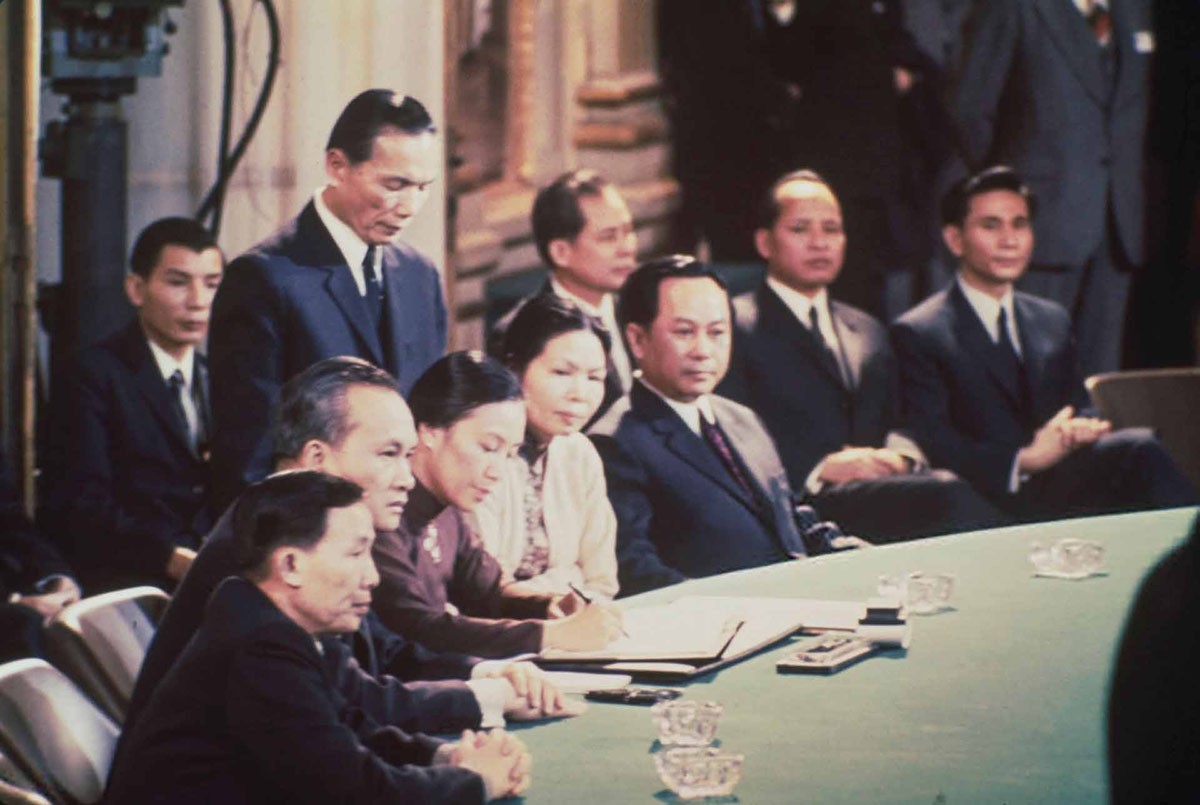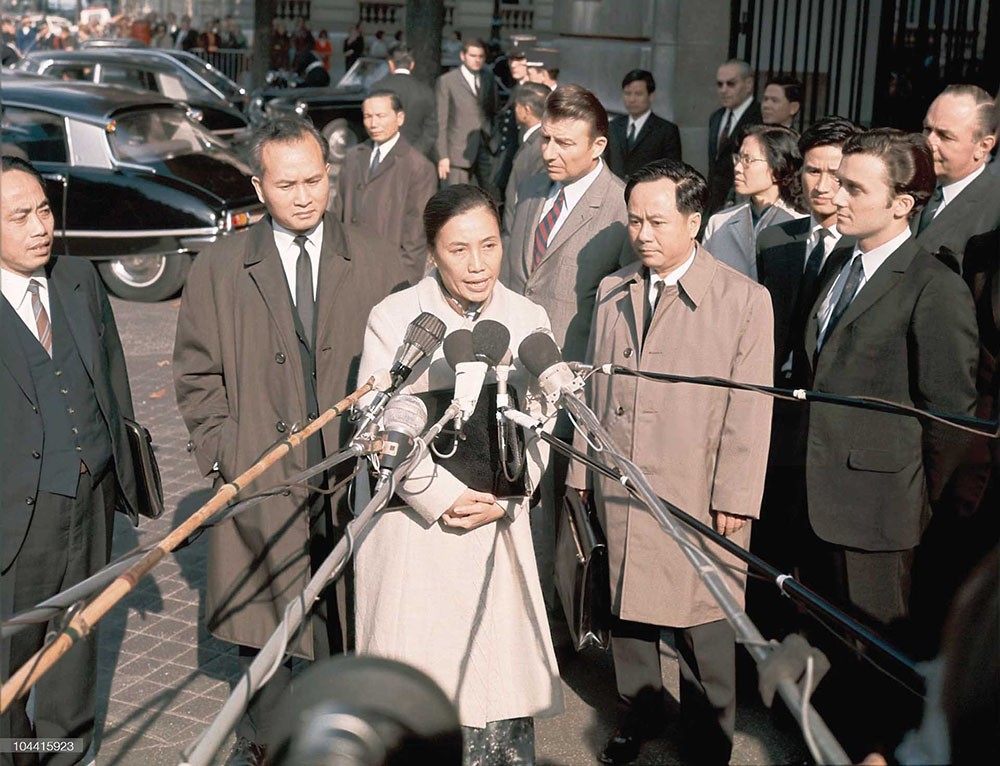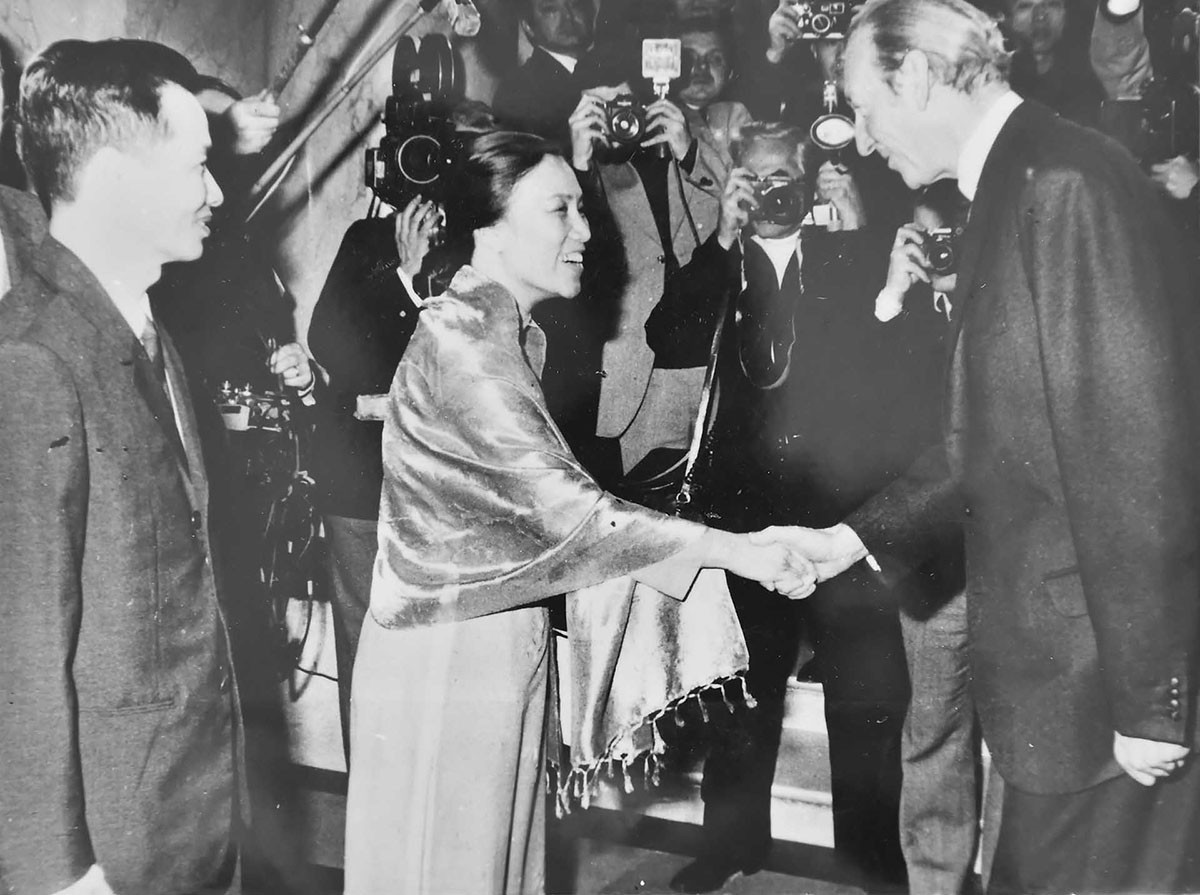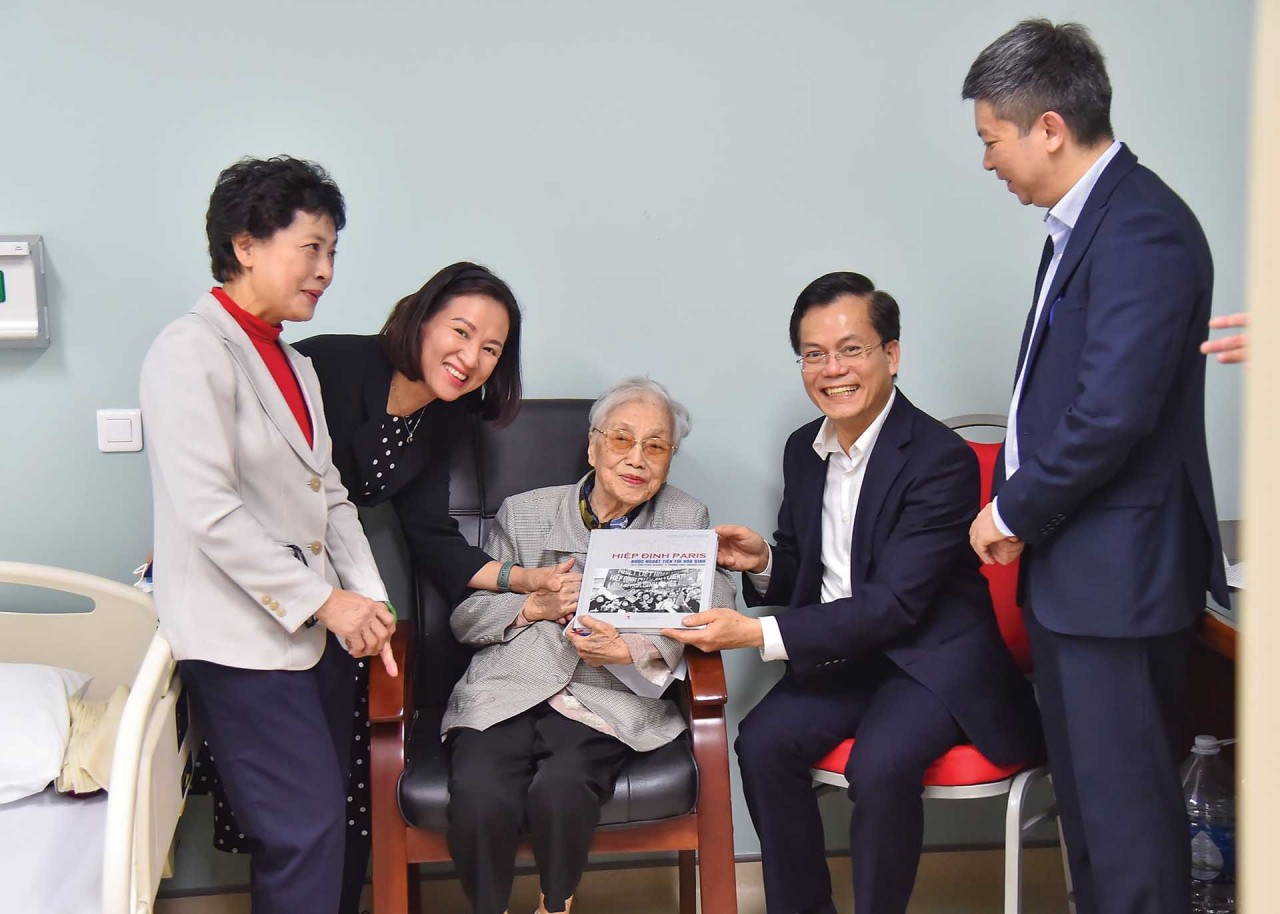
Signing of 1973 Paris Peace Accords led to peace and national reunification
Latest
 |
| Former Minister of Foreign Affairs of the Provisional Revolutionary Government of the Republic of South Vietnam Nguyen Thi Binh signs the Paris Peace Accords on January 21, 1973. |
The Paris talks among the concerned parties to end the war and restore peace in Vietnam were the longest negotiations in the diplomatic history, spanning four years, eight months and 14 days. It led to the signing of the Paris Peace Accords half a century ago, on January 27, 1973. To me, the Paris negotiations were akin to a roll of film, containing various significant milestones in our intense battles of wits, and the eventual triumph.
The first and foremost was the status of the National Front for the Liberation of South Vietnam, which was a party to the Paris negotiations.
In the afternoon of November 4, 1968, a delegation of the National Front for the Liberation of South Vietnam arrived at Paris-Le Bourget Airport. Upon meeting a crowd of the media at the airport, filled with uneasiness, touchedness, and happiness, we had the responsibility for clearly stating the reason and significance of the presence of the National Liberation Front at the Paris Conference.
Earlier, from May to October 1968, at bilateral meetings, the US side showed a very acrimonious attitude towards the role of the Front delegation, saying the Front was “backed by the North”. Our side stated that the Front represented the South Vietnamese people who were directly fighting against the US invaders, so it was a party to the negotiations as a matter of course. Meanwhile, the Saigon administration was set up by the US and acted as a henchman of the US.
Due to the adamant stance of the Government of the Democratic Republic of Vietnam, the US was forced to engage in official talks with the National Front for the Liberation of South Vietnam and from June 1969, the Provisional Revolutionary Government of the Republic of South Vietnam, which was an initial great political victory and of strategic significance.
 |
| Former Minister of Foreign Affairs of the Provisional Revolutionary Government of the Republic of South Vietnam Nguyen Thi Binh in an interview with foreign media. |
At the conference, we had two delegations sitting next to each other and sharing the same goal, which gave us many advantages to coordinate in the struggle. In terms of politics and diplomacy, we created a flexible and vivid disposition of “being two but one, being one but two” to bring into play our strength. The second important milestone in the negotiations was that we stayed steadfast in our principled stance while adopting flexible policies. The Paris talks showed the decisive importance of our Party’s strategic guidelines and clear-sighted and sound tactics, along with the role and significance of diplomacy in coordination with the military and political fronts. A right, flexible, and clever foreign policy could optimise results gained on the battlefield for the sake of ultimate victory.
In April 1969, I returned to Hanoi to receive new instructions. When coming back to Paris, I brought along the 10-Point Stance of the Front. On May 8, 1969, we proposed a “complete 10-point solution” to end the war and resolve the political issue in the South, which had a great impact, especially on the public in the US.
At the negotiating table, on September 17, 1970, we continued to put forth an eight-point statement demanding the US withdraw its troops before June 30, 1971, remove the Saigon administration, and establish a provisional coalition government in the South. The statement drew great attention in cities in the South and among the international public.
In 1971, the battlefield situation was very tense while the talks was also extremely fierce. Our delegation conducted “diplomacy coordinated with the battlefield”. After the “special war” and “local war” strategies had failed, the US advocated the Vietnamisation policy. Our position got stronger, and we held the position of counter-attack on the battlefield.
 |
| Former Minister of Foreign Affairs of the Provisional Revolutionary Government of the Republic of South Vietnam Nguyen Thi Binh and UN Secretary-General Kurt Waldheim who came to witness the signing ceremony as an observer at the Kléber International Convention Centre in Paris on March 2 in 1973. |
That situation led to the date of July 1, 1971, when we put forward a seismic seven-point solution: The US withdraws its entire troops in tandem with the release of prisoners; the Saigon administration steps down, making room for a new administration, and discusses with the Provisional Revolutionary Government to establish a government of national reconciliation. With this solution, we proactively divided the US withdrawal issue from the political issue in the South. This was a very important, flexible, and clever step.
In diplomacy, flexibility could also mean offensive. We firmly maintained our adamant and unyielding stance, fought in all the fronts of military, politics, and diplomacy amidst complicated relations among superpowers, while at the same time seeking a most advantageous solution to get out of the war and secure victory.
After that, in early 1972, we put forth a two-point statement that the US must withdraw its troops and a three-component government of national reconciliation must be set up in the South. This demonstrated “a big policy” that was temporarily put aside the political issue in the South to focus on forcing the US to withdraw its troops, which had a great and timely impact that pushed the adversary into a passive position.
After the 1972 Spring - Summer victory in five major battlefields, from Tri Thien to the Cuu Long (Mekong) Delta, we liberated a large area, changing the correlation of forces and creating a possibility of ending the war. In July 1972, the Political Bureau decided to shift from the war strategy to the peace strategy.
 |
| Former Minister of Foreign Affairs of the Provisional Revolutionary Government of the Republic of South Vietnam Nguyen Thi Binh meets with representatives of Vietnamese overseas in Paris on January 28, 1973. |
In Paris, the Democratic Republic of Vietnam and the US began “secret” negotiations - a historic battle of wits, the two fronts of military and diplomacy entered a fierce phase. In late September 1972, we proposed the “draft Paris Agreement on ending the war and restoring peace in Vietnam”.
In early October 1972, the two sides basically agreed on the Draft and planned to sign the agreement on October 30. However, in early November 1972, the US side changed its mind, demanding the Accords be amended in a way beneficial to it. And to put pressure on us to accept, the US launched B.52 airstrikes on Hanoi and Hai Phong from December 18-29, 1972.
On December 21, we declared off the talks to express our opposition. The negotiations were pushed to an extremely tense situation. The airstrike campaign failed, the US had to stop bombing and accepted the Draft. On January 23, 1973, we and the US initialed the Accords, and in the morning of January 27, 1973, the Accords was officially signed, stating the respect for the fundamental national rights of independence, sovereignty, unity, and territorial integrity of Vietnam.
One month later, on March 2, 1973, an international conference was held to make legal certification of the Paris Peace Accords, with the participation of representatives from 12 countries and the parties concerned, along with the UN Secretary-General as a guest at the conference; and to issue an international act on Vietnam.
The success of the signing of the 1973 Paris Peace Accords, with the US having to withdraw its entire troops from the South, was an extremely important and decisive stride towards the ultimate victory of the South liberation and national reunification on April 30, 1975.
This was also the great historic significance of the Paris talks - another memorable milestone that I want to look back, another step of victory towards the complete victory.
The 1973 Paris Peace Accords was signed, but in fact not everything went smoothly, the war remained fierce. The US and the Saigon administration did not seriously comply with the Accords but strived to re-occupy the liberated areas under their “overwhelming territory” plan. We still had to continue fighting against the adversary while struggling within the Four- and Two-Party Joint Military Commissions, based at Tan Son Nhat Airport, as in line with the roadmap for implementing the articles on military in the Accords.
 |
| Former Vice President, former Minister of Foreign Affairs of the Provisional Revolutionary Government of the Republic of South Vietnam Nguyen Thi Binh with Deputy Foreign Minister Ha Kim Ngoc an Deputy Editor-in-Chief of the World and Vietnam Report Nguyen Thi Minh Nguyet, January 2023. |
The preparation for a bilateral consultative conference in the South under Article 12 of the 1973 Paris Peace Accords lasted for more than one month - from March to April 1973 - at the La Celle Saint-Cloud castle in Paris, but did not make any progress and had to be dissolved.
Meanwhile, on the battlefield, bombs and bullets still detonated and blood was still shed. In early 1975, the situation changed in a way that was beneficial to us, we launched strong counter-attacks and continuously pushed the troops of the Saigon administration to a passive position and defeated them everywhere.
I was assigned to make a visit to European countries in anticipation of the US’s re-intervention. We also built some scenarios to prepare for different circumstances amid our forces strongly and unceasingly advancing to Saigon.
In the evening of April 29, 1975, after returning from Tanzania, I arrived in Da Nang and was very happy and cheerful when listening to a radio report that our troops had entered Saigon, and at noon on the next day, April 30, 1975, Saigon was liberated - a source of unbounded emotion to me.
In November 1975, a consultative conference on national reunification took place. The Provisional Revolutionary Government of the Republic of South Vietnam accomplished its historic mission. Vietnam became reunified.
The diplomatic struggle at the Paris Conference left many lessons. I think that the biggest lesson among Vietnam’s guidelines is the policy of independence and self-reliance, from concrete policies to the general policy. An extremely important thing that leaders always paid attention to when making policies and decisions was to assess the overall world situation, especially the Vietnam-related intentions of big countries and their relations with each other.
We firmly maintained the stance of independence and self-reliance during the war as well as after the war ended, while still making the most of the support from international friends. The unprecedentedly massive movement of solidarity with Vietnam was also an important factor contributing to the victory of our people’s struggle.
President Ho Chi Minh used to say: “National solidarity is connected with international solidarity”, and that “it is important to combine the strength of the people with the strength of the era”, which is the combination of internal and external resources into a united general force to obtain success.
That is forever true to the Fatherland construction and defence process at present and further in the future, especially in the context of intensive and extensive international integration, political independence must be concomitant with economic independence and self-reliance.
In any circumstance, our people also need international solidarity and support, and need to stay steadfast in safeguarding independence, sovereignty, and territorial integrity. It is also necessary to understand that only when national solidarity is solid can strong international solidarity be secured.
* Former Vice President of the Socialist Republic of Vietnam, Former Minister of Foreign Affairs of the Provisional Revolutionary Government of the Republic of South Vietnam.













